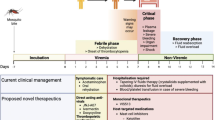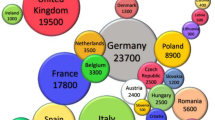Abstract
Nirsevimab (Beyfortus®), a long-acting intramuscular recombinant neutralising human IgG1ĸ monoclonal antibody to the prefusion conformation of the respiratory syncytial virus (RSV) F protein that has been modified with a triple amino acid substitution in the Fc region to extend the serum half-life, is being jointly developed by AstraZeneca and Sanofi for the prevention of RSV disease. The extended serum half-life allows administration of nirsevimab as a single dose to cover the RSV season. Nirsevimab was approved in the EU on 3 November 2022 and in the UK on 7 November 2022 for the prevention of RSV lower respiratory tract disease in neonates and infants during their first RSV season. This article summarizes the milestones in the development of nirsevimab leading to this first approval for the prevention of RSV disease in all infants.
Similar content being viewed by others
References
European Medicines Agency. New medicine to protect babies and infants from respiratory syncytial virus (RSV) infection [media release]. 16 Sep 2022. https://www.ema.europa.eu/en/news/new-medicine-protect-babies-infants-respiratory-syncytial-virus-rsv-infection.
Esposito S, Abu Raya B, Baraldi E, et al. RSV prevention in all Infants: which is the most preferable strategy? Front Immunol. 2022. https://doi.org/10.3389/fimmu.2022.880368.
National Center for Immunization and Respiratory Diseases (NCIRD) Division of Viral Diseases. RSV in infants and young children. 2020. https://www.cdc.gov/rsv/high-risk/infants-young-children.html. Accessed 20 Sep 2022.
Shi T, McAllister DA, O’Brien KL, et al. Global, regional, and national disease burden estimates of acute lower respiratory infections due to respiratory syncytial virus in young children in 2015: a systematic review and modelling study. Lancet. 2017;390(10098):946–58.
Hall CB, Weinberg GA, Iwane MK, et al. The burden of respiratory syncytial virus infection in young children. N Engl J Med. 2009;360(6):588–98.
SOBI. Palivizumab (SYNAGIS®): US prescribing information. 2021. https://synagishcp.com/. Accessed 24 Nov 2022.
Ginsburg AS, Srikantiah P. Respiratory syncytial virus: promising progress against a leading cause of pneumonia. Lancet Glob Health. 2021;9(12):e1644–5.
Eichinger KM, Kosanovich JL, Lipp M, et al. Strategies for active and passive pediatric RSV immunization. Therap Adv Vaccines Immunother. 2021. https://doi.org/10.1177/2515135520981516
Meissner HC. Disarming the respiratory syncytial virus. N Engl J Med. 2020;383(5):487–8.
European Medicines Agency. Nirsevimab (Beyfortus): EU summary of product characteristics. 2022. https://www.ema.europa.eu/. Accessed 22 Nov 2022.
Sanofi. European Commission grants first approval worldwide of Beyfortus® (nirsevimab) for prevention of RSV disease in infants [media release]. 4 Nov 2022. https://www.sanofi.com/.
AstraZeneca. Beyfortus approved in the EU for the prevention of RSV lower respiratory tract disease in infants [media release]. 4 Nov 2022. https://www.astrazeneca.com/.
Sanofi. MHRA grants approval of Beyfortus®(nirsevimab) for prevention of RSV disease in infants [media release]. 9 Nov 2022. https://www.businesswire.com/news/home/20221109005601/en/MHRA-Grants-Approval-of-Beyfortus%C2%AE%E2%96%BC-nirsevimab-for-Prevention-of-RSV-Disease-in-Infants.
Medicines & Healthcare products Regulatory Agency. Nirsevimab (Beyfortus): UK prescribing information. 2022. https://products.mhra.gov.uk/search/?search=NIRSEVIMAB&page=1&doc=Spc%7CPar&ter=GB&rerouteType=0. Accessed 24 Nov 2022.
Sanofi. Sanofi Pasteur and MedImmune collaborate on monoclonal antibody to prevent illnesses associated with RSV [media release]. 3 Mar 2017. https://www.sanofi.com/.
MedImmune. MedImmune and Sanofi Pasteur form alliance to develop and commercialise potential next-generation respiratory syncytial virus antibody MEDI8897 [media release]. 3 Mar 2017. https://www.astrazeneca.com/.
AIMM Therapeutics. AIMM Therapeutics partner MedImmune starts clinical studies with RSV antibody [media release]. 2 Jul 2014. https://www.businesswire.com/news/home/20140702005318/en/AIMM-Therapeutics%E2%80%99-Partner-MedImmune-Starts-Clinical-Studies-with-RSV-Antibody.
MedImmune Ltd, AIMM Therapeutics BV. RSV-specific binding molecules and means for producing them. 2013. https://patents.google.com/patent/US8562996B2/. Accessed 24 Nov 2022.
Zhu Q, McLellan JS, Kallewaard NL, et al. A highly potent extended half-life antibody as a potential RSV vaccine surrogate for all infants. Sci Transl Med. 2017;9(388):eaaj1928.
Zhu Q, Lu B, McTamney P, et al. Prevalence and significance of substitutions in the fusion protein of respiratory syncytial virus resulting in neutralization escape from antibody MEDI8897. J Infect Dis. 2018;218(4):572–80.
Hammitt LL, Dagan R, Yuan Y, et al. Nirsevimab for prevention of RSV in healthy late-preterm and term infants. N Engl J Med. 2022;386(9):837–46.
Griffin MP, Yuan Y, Takas T, et al. Single-dose nirsevimab for prevention of RSV in preterm infants. N Engl J Med. 2020;383(5):415–25.
Domachowske J, Madhi SA, Simões EAF, et al. Safety of nirsevimab for RSV in infants with heart or lung disease or prematurity. N Engl J Med. 2022;386(9):892–4.
Wilkins D, Yuan Y, Aksyuk A, et al. Nirsevimab for the prevention of respiratory syncytial virus infection: neutralizing antibody levels following a single dose. [abstract no. O005/#905]. In: 40th Annual Meeting ESPID 2022 Congress. 2022.
Author information
Authors and Affiliations
Corresponding author
Ethics declarations
Funding
The preparation of this review was not supported by any external funding.
Authorship and conflict of interest
During the peer review process the developer and commercializing partner of the agent under review was offered an opportunity to comment on the article. Changes resulting from any comments received were made by the authors on the basis of scientific completeness and accuracy. Susan J. Keam is a contracted employee of Adis International Ltd/Springer Nature, and declares no relevant conflicts of interest. All authors contributed to the review and are responsible for the article content.
Ethics approval, Consent to participate, Consent to publish, Availability of data and material, Code availability
Not applicable.
Additional information
This profile has been extracted and modified from the AdisInsight database. AdisInsight tracks drug development worldwide through the entire development process, from discovery, through pre-clinical and clinical studies to market launch and beyond.
Supplementary Information
Below is the link to the electronic supplementary material.
Rights and permissions
Springer Nature or its licensor (e.g. a society or other partner) holds exclusive rights to this article under a publishing agreement with the author(s) or other rightsholder(s); author self-archiving of the accepted manuscript version of this article is solely governed by the terms of such publishing agreement and applicable law.
About this article
Cite this article
Keam, S.J. Nirsevimab: First Approval. Drugs 83, 181–187 (2023). https://doi.org/10.1007/s40265-022-01829-6
Published:
Issue Date:
DOI: https://doi.org/10.1007/s40265-022-01829-6




